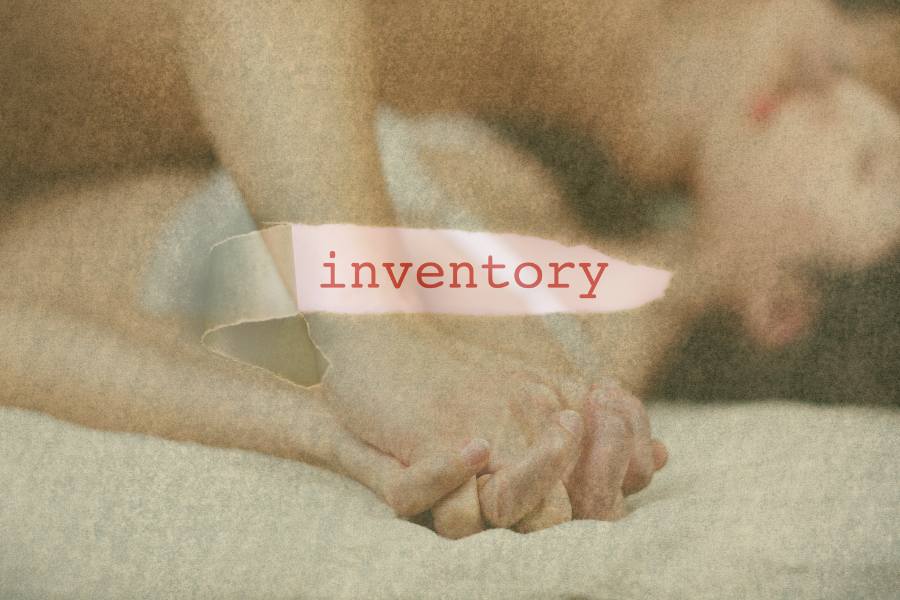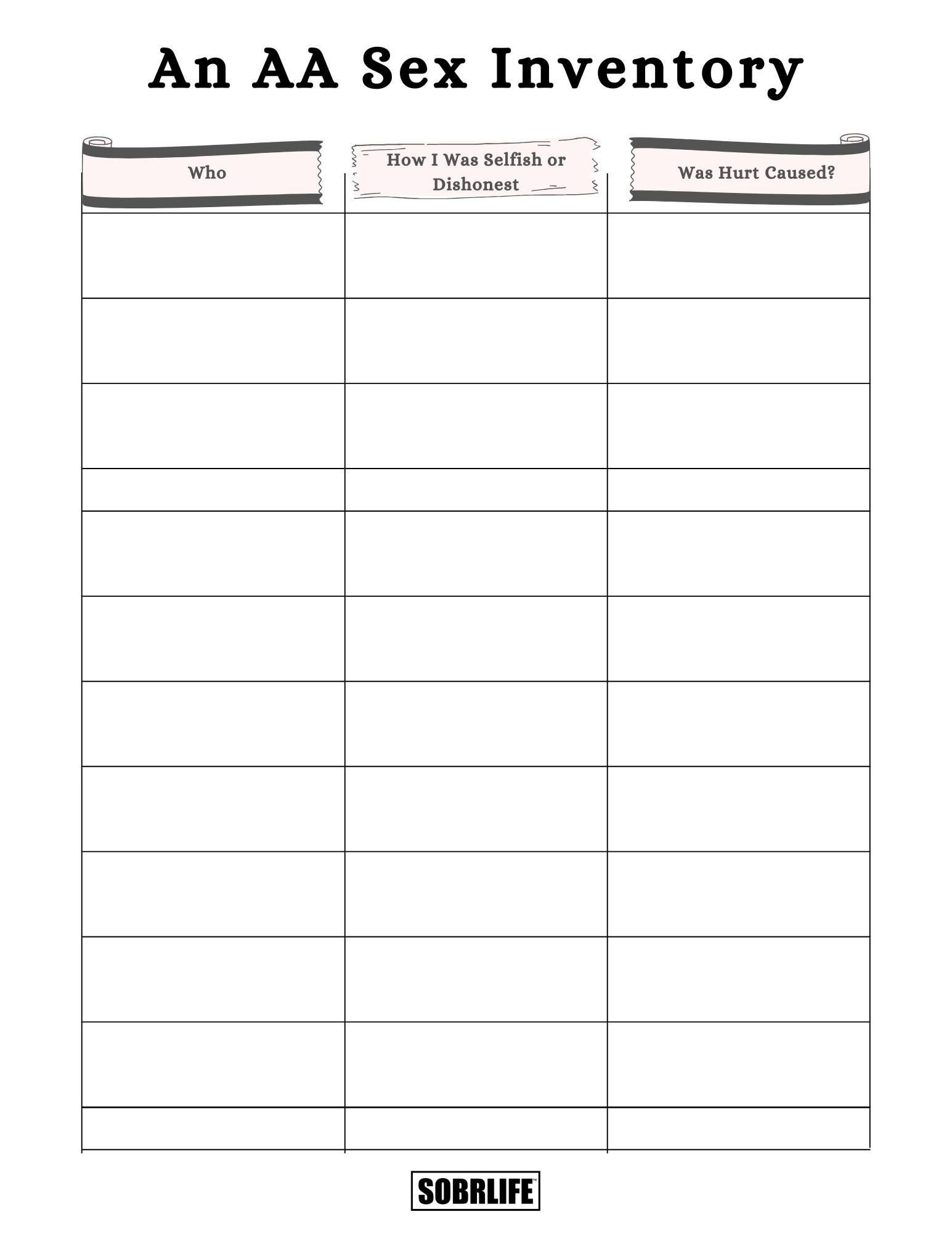AA Sex Inventory Guidance and Worksheet
Taking Stock of Intimacy and Sex in Our Lives Before Sobriety
Welcome to all in the sober community, our SOBRLIFE friends and family (and any ‘normies’ too) interested in a topic that attracts a lot of attention, and yes, anxiety as well. And if you’re reading this you’re probably curious about or thinking about doing the AA sex inventory process.
I’ve been in recovery for over 10 years and this was a big one for me, so I’m happy to share my experience with you, plus a worksheet our team here created to help things go more smoothly.
What is the AA Sex Inventory?

First off, let’s define this form of inventory. As you likely are aware, it is part of the Fourth Step in the Twelve Steps of Alcoholics Anonymous, which says:
“Made a searching and fearless moral inventory of ourselves.”
This step covers all of our lives but the sex inventory focuses on our sexual history and behavior.
The fourth step of inventory is a thorough examination of our sexual conduct and relationships, to be honest, and to look within to grow spiritually in recovery and to align our actions with a higher power.
Now you’re probably thinking: “Why in the world do I need to go into my sex life to stay sober?”
I thought the same thing when I first came across this part of the program. But as I’ve learned on my journey our sexual behavior and relationships are often tied to our addiction.
The Big Book of Alcoholics Anonymous (2001, 4th edition, Chapter 5) says on page 69:
“We reviewed our own conduct over the years past. Where had we been selfish, dishonest, or inconsiderate? Whom had we hurt? Did we unjustifiably arouse jealousy, suspicion, or bitterness? Where were we at fault, what should we have done instead? We got this all down on paper and looked at it.”
Why is the Sex Inventory Important?
You’re probably wondering why we need to go into our sexual past and behavior. Here’s a quick breakdown of why we conduct an inventory of our intimate relationships:
- Uncover behavior patterns: Often our sexual behavior is tied to our addiction in ways we don’t even realize. By looking back we can identify behavior patterns that are holding us back in recovery. Identifying destructive patterns can prevent us from repeating harmful behavior in the future.
- Address shame and guilt: We carry a lot of shame and guilt around our sexual past. The inventory process helps us face those feelings and heal.
- Better relationships: By understanding our past behavior and motivations we can work towards healthier relationships in the future.
- Honesty: The inventory process requires complete honesty with ourselves which is key to long-term recovery. And honesty, along with open-mindedness and willingness, are pillars of AA as a whole, and working a solid program on an individual basis as well.
Looking at Sexual Conduct in My Life

Let’s be clear: when I first started my sex inventory I was scared. I mean who wants to look that closely at their past mistakes and failures? However, my sponsor told me to push through the discomfort and reminded me growth happens outside our comfort zone, and I’ll give credit where it is due, he was right on that.
I sat down with a lined notebook, feeling a mix of anxiety and determination, thinking it would be a quick and dirty list. Then, as I started writing I was surprised by how much I had buried or forgotten. There were relationships I had sabotaged, people I had hurt, and times I had used sex to numb my feelings or boost my ego.
Remember: it is not about judging anyone’s sexual conduct and behavior but our own.
It wasn’t easy but with each page I wrote I felt a little lighter. I was finally facing the truth about my past behavior and identifying my defects of character and in doing so I was taking the first step to changing them.
I had not written long, and it wasn’t like I was writing poems or anything detailed, but a load was lifted still.
The Process: How to do the Fourth Step Inventory
Now let’s get into the how-to. Remember this is a personal process and there’s no one right way to do it. But here’s what I found helpful:
- Find a quiet place where you won’t be disturbed.
- Get a notebook or open a new document on your computer.
- Start by listing all your sexual relationships and encounters. Be thorough and honest.
- For each item on your list ask yourself:
- Was I selfish or dishonest in this situation?
- Did I manipulate or use this person?
- Did I hurt or harm anyone (including myself)?
- Was I faithful and considerate?
- Was I driven by fear, self-deception, or self-seeking?
Download our Worksheet for the Sex Inventory Process Here
Hopefully, all these questions have begun to show just how doing a relationship inventory is key to looking at our behavior in intimate and romantic relationships. It helps us identify patterns of behavior that can lead to personal growth and better relationships, not to mention better, well, sex in recovery.
- Look for patterns in your behavior. Are there common themes or motivations?
- Be honest with yourself. Were there times you used sex to avoid feelings or problems?
- How was your sexual behavior tied to your drinking or drug use?

Remember the goal isn’t to beat yourself up or dwell on past mistakes. It’s about getting clarity and understanding so you can move forward in your recovery.
Sex Inventory Challenges and How to Overcome Them

Let’s be real once again: this process isn’t easy. Here are some common challenges you might face and how to deal with them:
- Shame and guilt: It’s normal to feel ashamed or guilty when looking at past behavior. Remember you’re doing this to heal and grow not to punish yourself. Be kind to yourself throughout this process.
- Fear of judgment: You might worry what others will think if they knew your past. Remember this inventory is for you, not anyone else. You don’t have to share anything you’re not comfortable with.
- Difficulty remembering: If you can’t remember everything that’s okay. Just be as honest and thorough as you can with what you do remember.
- Feeling overwhelmed: If it feels too much to handle break it down into smaller chunks. You don’t have to do it all in one sitting.
- Triggered memories: Sometimes looking back can bring up painful memories or trauma. If this happens don’t hesitate to reach out to your sponsor or a therapist for support.
The Benefits: What I’ve Gained
Now I know I’ve talked a lot about the challenges of this process. But I want to emphasize it’s also very rewarding. Here are some of the benefits I’ve experienced:
- Greater self-awareness: The inventory process helped me know myself better, including my motivations and triggers.
- Better relationships: By addressing my past behavior I’ve been able to build healthier more honest relationships in recovery.
- Release from shame: Facing my past head-on allowed me to let go of a lot of shame I had been carrying and paved the way for a healthier future sex life.
- Better emotional regulation: Understanding the link between my sexual behavior and my emotions has helped me develop healthier coping mechanisms. Having a sound ideal can lead to healthier interactions and emotional healing.
- Stronger recovery: This process deepened my commitment to recovery and helped me identify where I needed to focus my efforts.
Moving Forward: What Comes After the Inventory for Your Future Sex Life
You’ve completed your sex inventory that’s a big deal but it’s not the end of the process. Here’s what comes next:
- Share with your sponsor: In Step Five you’ll share your inventory with your sponsor or another trusted person. This can be scary but it’s part of the healing process and helps you bring your character defects to your higher power.
- Make amends: Steps Eight and Nine involve making a list of people you’ve harmed and making amends where possible. This might include some of the people you identified in your sex inventory.
- Continue to practice honesty: Use what you’ve learned to continue practicing honesty in your relationships and sexual behavior. Defining a ‘sex ideal’ is key to understanding how to pursue healthier more fulfilling relationships moving forward.
- Seek additional support if needed: If your inventory has brought up issues you need additional help with consider seeking therapy or joining a support group focused on healthy relationships and sexuality.
- Practice gratitude: Be grateful for the growth and healing this process has brought you. It’s not easy but it’s a journey that can lead to big transformation.
Becoming Part of the Recover Out Loud Community

Just like making amends in AA, the sex inventory is a hard but very valuable part of getting sober. It’s an opportunity for deep self-reflection, healing, and growth, at least it was for me and many of the men and women I know who have done a thorough job on this.
Remember you’re not alone. Reach out to your sponsor, others in the AA community, or a trustworthy mental health professional if you need support.
As you do this process be patient and kind to yourself. Recovery is a path, not a destination; and every inch forward you take gets you closer to the life you want to live. Your future self will thank you for doing this work, no matter how tough it can seem in the present at times.
Join Us in Living the SOBRLIFE and Shatter the Stigma
And, as a regular contributor to SOBRLIFE, I encourage you to write us anytime with your thoughts and questions about all topics related to the recovery process and to getting and staying, sober. And we’re always looking for new writers to send in their thoughts (and articles too) that the recovery community needs to hear!
Stay strong, stay honest, and keep moving forward on your path to recovery. You’re worth it!
